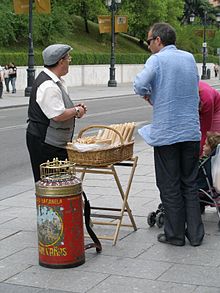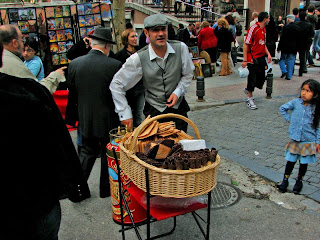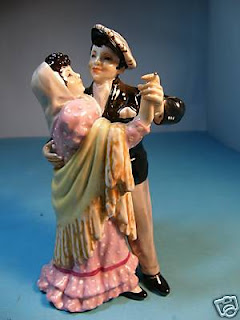It's a thin sheet of pasta made with flour, without yeast, and sugar or honey and, usually, cinnamon.
Today is a sweet that is often traditionally offered on the streets of Madrid.
It seems that the origin of the wafers can be found directly at the beginning of Christianity, and which derive directly from the divine bread. Since then its membership has evolved. The "barquillos" were developed in the monasteries where they tasted before selling it to the faithful and probably their sweet culinary evolution is due to the refinement of the religious. In the Middle Ages it were part of the tables of kings and great lords and also sold on the street.
In Zaragoza, Madrid, in many cities, there have been stories and characters linked to the "barquillos", for example in Madrid, is typical figure of the "barquillero", and it's customary to see them at times and feasts.
( Mariona Estruga)
Welcome everybody!! Here we have a blog about Madrid, the members of this blog will write about the traditions of Madrid such as the dancings, the songs, the food, etc We will also talk about what the feelings for a Catalan to visit the Spanish capital are. Thanks for the visit and follow us. (Lluís Espallargas) We are going to visit Madrid next March and, there, we are going to take a lot of photos and we are also going to do interviews to find out what the people think! ( Paula Sobrino)
Which route do you prefer?
sábado, 24 de diciembre de 2011
viernes, 23 de diciembre de 2011
"EL CHOTIS"
Chotis is a traditional dance of Madrid, is danced mainly during the celebrations of San Isidro.
The schottische arrived in Madrid in 1850 and danced for the first time at the Royal Palace, the night of November 3 of that year, under the name of German polka. Since that time, he achieved great popularity and became a more traditional dance of the people of Madrid, to become a symbol of the holiday Madrid.
It is danced in couples face to face, and during the dance women revolves around the man, which rotates on its own axis. It is said that the man does not need more space from one tile to dance it.
The schottische arrived in Madrid in 1850 and danced for the first time at the Royal Palace, the night of November 3 of that year, under the name of German polka. Since that time, he achieved great popularity and became a more traditional dance of the people of Madrid, to become a symbol of the holiday Madrid.
It is danced in couples face to face, and during the dance women revolves around the man, which rotates on its own axis. It is said that the man does not need more space from one tile to dance it.
Women tend to dance it men and a Manila shawl-clad tend to look a parpusa (a type of beret) on his head.
Alba Vilavella
martes, 20 de diciembre de 2011
HELLOOOOOOOO
Hi, there!!
Next March we are travelling to Madrid on our final ESO trip. We are very excited and discovering the tradicions. This is what our blog is going to be about. Wait and see......
Next March we are travelling to Madrid on our final ESO trip. We are very excited and discovering the tradicions. This is what our blog is going to be about. Wait and see......
Suscribirse a:
Entradas (Atom)



